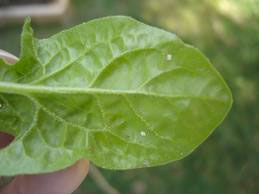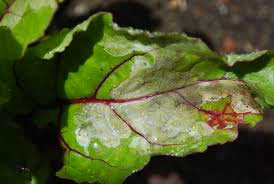Many of you have expressed concern over your spinach plants that appear to be drying out. I’ve done a little research and it looks like what we have here is a Spinach leaf miner. Removing infected leaves prevents the larvae from pupating, burrowing in to the soil and returning later as egg-laying adults, which starts the cycle of damage over again. This will be especially in important for long-standing plants like Swiss Chard.
In short, the eggs (white fleck on the underside of leaves) are the eggs of the Spinach Leafminer Fly, and once hatched feed on the tissue within the leaf. hence the name ‘leaf miner.” “The maggots feed between the upper and lower leaf surfaces of the host plants mining out the tissue in between. As the maggot grows, the mines coalesce with others and blotches are seen on the affected leaves. It is not unusual for several larvae to be in the same leaf”
If you have the time an inclination, crushing those eggs on the undersides of leaves will limit hatching.
Management from Cornell University is as follows:
Management: Because this insect overwinters as a puparium in the soil near where the crop was infested the previous year, crop rotation should be practiced especially if one tries to mechanically protect plants from this insect. Cover plants with fine netting or cheesecloth or floating row covers to protect them from adult egg-laying flies. Netting will not keep out insects that are already in the soil. Be sure that the edges of the row cover are well anchored so insects cannot get under them. The protective covering should be placed over the crop at planting time and, with spinach, might be left on until ready to harvest. Hand pick and destroy infested mined leaves when first seen before the larvae drop to the soil will help control the leafminers. If leaves are just placed on a compost pile, fly larvae might continue to develop and emerge as adults to reinfest crops.”
Control weeds. Destroying the insects’ wild food plants should also be helpful in reducing the numbers of leafminers. This includes lamb’s-quarters, chickweed and nightshade in and around the garden Control in beets: Beets are typically not sprayed for leafminers except if leaves intended for consumption are infested. Use horticultural oil, or neem oil. Some products require a longer number of days between application and harvest; check labels.
Control in spinach: If needed when mines appear and, if necessary, at seven-day intervals thereafter (check label directions), apply neem oil, or spinosad.
Note: a multipurpose product with insecticidal soap and sulfur should not be used as noted on the label; it damages spinach.
I hope this is helpful….
Regina Dlugokencky
Regina Dlugokencky
UPDATE
Spinosad will do less leaf damage then Neem. It is available labeled for other insects. I use Bonide’s Organic Potato Beetle spray available at Home Depot. Spinosad is made from the residue from bacteria in the production of Rum and is safe to use up to harvest. If you use Neem, spray it on a few test leaves to see if it affects the leaf and makes them unpalatable.
Spinosad will do less leaf damage then Neem. It is available labeled for other insects. I use Bonide’s Organic Potato Beetle spray available at Home Depot. Spinosad is made from the residue from bacteria in the production of Rum and is safe to use up to harvest. If you use Neem, spray it on a few test leaves to see if it affects the leaf and makes them unpalatable.
Larry Foglia
Leafminer Fly




